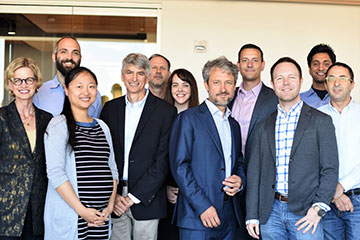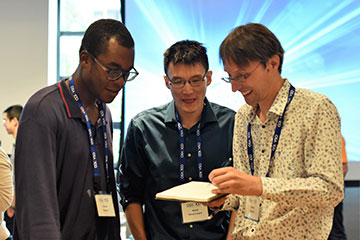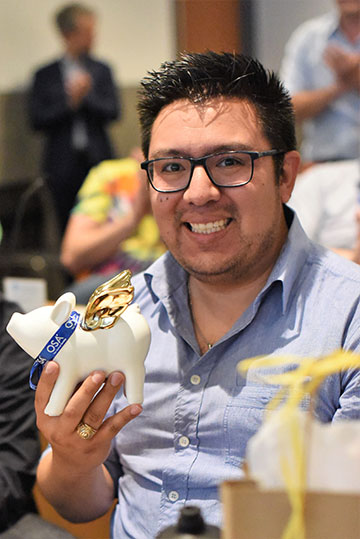
All of the pitch panel judges with OSA CEO Liz Rogan (far left) on the final day of the OSAF Innovation School, including Sam Rubin (far right) and Gary Cohen (back row, center). [Image: Monique Rodriquez / OSA]
The OSA Foundation (OSAF) hosted its second annual Innovation School in late July 2018 at OSA headquarters in Washington, D.C. The school is a highly interactive program, aimed at those seeking to participate in the innovation economy—whether as an innovator within a larger company or at a startup venture, or as an entrepreneur.
The four-day bootcamp culminated with each team of students pitching an innovative idea to a panel of industry experts, tasked with evaluating the team presentations and determining the winner. OPN caught up with two of the pitch panel judges, Sam Rubin, general manager, Thorlabs, Inc., and Gary Cohen, executive director, RadTech–UV+EB Technology Association, and International Ultraviolet Association, to pick their brains on what makes a successful innovator.
As a pitch panel judge, what were you looking for in a team pitch?
Rubin: The three main areas I looked for were: how promising is their idea, how well have they developed their idea using the skills and tools taught at the workshop and, lastly, what their plans for next steps are.
Cohen: I was interested to hear about the target customer and how the tech may uniquely fulfill their needs. Sometimes, for example, innovators may focus on the final end-user customer, when the real or most helpful customer for the technology may be an intermediary (who may ultimately serve as the provider and facilitator of the product). For the most part, the teams seemed to have the right focus.

David Wong Campos (center) interviews Emeka Ikpeazu (left) and Stefan Persijn (right) as potential pitch team members. [Image: Monique Rodriquez / OSA]
What sets apart a “high-potential idea”?
Rubin: Creating value. The most important thing is the value an idea creates and for whom.
Cohen: High-potential ideas must start with a baseline of meeting cost expectations of legacy technologies, and then offer a fundamental trigger that helps to change mind sets to understand the value of a new innovation. Often, it may provide a solution that current technology doesn’t offer. Sometimes regulations addressing sustainability concerns may help.
Was there a standout presentation? What made it special?
Rubin: The presentations of all teams were effective and communicated their messages well, indicating that they all implemented what they learned in the workshop. For me, one team, “Connectify,” stood out because their idea addresses a real need (the difficulty to schedule time with a service provider) and creates a real value (saves you time). It was clear that they came up with the idea through multiple iterations of customer feedback and brainstorming, and that they applied the teachings of the program.
Cohen: You could tell that in a short time there was considerable interaction, learning and preparation—with delightful videos, graphics and research developed by each team. Each presentation offered new, interesting and novel information. Congratulations to all the teams!
If you had one piece of advice for someone who wanted to become an entrepreneur or get a startup off the ground, what would it be?
Rubin: Think carefully about how you are creating value for your customer, and how to make sure that the customer sees that and understands how that value will enrich their lives.
Cohen: The emphases of the OSA Innovation School offer an excellent guide. It is about education—learning about your market, talking with customers. Preparation is key.

The winning team pitch was PAX, a sensor device you can add to any wearable that uses fluorescence detection to directly monitor and track stress levels in real time throughout the day. Team member Esteban Carbajal of Zemax holds the “flying piggy bank” trophy, which was awarded to PAX so the team can start saving money to get their winning idea off the ground. [Image: Monique Rodriquez / OSA]
Looking past the science, what practical aspects of a business plan often get overlooked?
Rubin: How to create and maintain a competitive advantage. Often, people focus on the idea—why it is good, what it does and how they will develop it—and forget to plan for the day that they will have competition.
Cohen: One of my innovators lamented that he is “‘building a better mousetrap,’ but no one is interested in a better mousetrap.” It is unfortunate that some excellent plans never become a success. The focus has to be on ensuring there is an accepted need (or finding a way to sell that need).
How can an aspiring entrepreneur get investors on his/her side in an innovation pitch presentation?
Rubin: Practice the presentation. Make sure you cover all key elements and have a good flow.
Cohen: Beyond all the emphasis on plans, financials and fitting in with the investor group, for many it is simply about differentiating themselves or their innovation. Find a way to surprise and delight an investor.
As an industry expert, how valuable is fostering scientific innovation?
Rubin: Extremely. One cannot speak enough about how much advancement in our field comes from such innovations. In addition to the well-known startup innovation, many photonics advancements actually come from innovations inside existing companies and businesses.
Cohen: My group focuses on using ultraviolet energy and electron beams as a replacement for legacy processes that may use harsh industrial machinery and chemicals. Innovation is vital to our group to develop applications for new processes.
The OSA Innovation School offers training for those who want to innovate within an established company, in addition to those who want to develop startup ventures. I think this is an excellent focus, and if asked to partner in the future, I look forward to encouraging individuals from established companies to participate.
